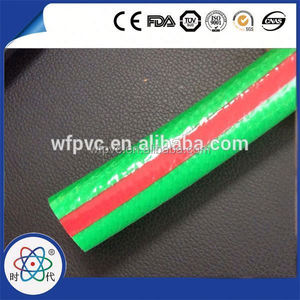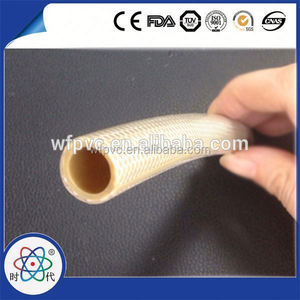(1772 products available)










































































































































































The PVC shrinking hose is a type of shrink tubing that is used for insulation, bundling wires, and connectors. It is made from polyvinyl chloride material, which shrinks when heated. The hoses come in various sizes and colors to accommodate different applications. PVC shrinking hoses are used in industries such as automotive, electronics, and telecommunications to provide protection against moisture, dust, and mechanical wear.
The PVC shrinking hoses can be classified into several types based on their usage and characteristics:
General purpose PVC shrink hose
This is the most commonly used shrink tubing made from PVC material. It is suitable for general applications where there is no extreme environment or high temperature. It protects wires and cables from moisture, dust and mechanical damage.
Heavy duty PVC shrink hose
This type of shrink tubing is used in areas where hoses are likely to be subjected to impacts or harsh environmental conditions. Heavy duty PVC shrink hoses are thicker and provide better protection than general purpose hoses.
Electrical grade PVC shrink hose
These shrinking hoses are used for insulating electrical components and preventing short circuits. They have high dielectric strength and can withstand electrical stress. Electrical grade PVC shrink hoses are used in automotive, telecommunications and industrial applications.
Medical grade PVC shrink hose
As the name suggests, these shrinking hoses are used in medical devices and equipment. They are made from non toxic materials and are resistant to sterilization processes. Medical grade PVC shrink hoses are used for insulating wires in surgical instruments and protective coverings for catheters.
Food grade PVC shrink hose
Food grade PVC shrink hoses are used in packaging and processing of food products. They provide protection against contamination and damage. Food grade hoses are made from materials that comply with food safety regulations.
Clear PVC shrink hose
Clear PVC shrink hoses are transparent and allow visibility of the underlying components. They are used in applications where it is important to see the protected wires or cables. Clear hoses are commonly used in commercial and retail settings for showcasing products.
Colored PVC shrink hose
Colored PVC shrink hoses are available in different colors to help with identification and coding. They are used in industries where color coding is required for safety and organization. Colored hoses provide the same protection as clear hoses but are more easily identifiable.
Material Composition:
The main material used to make PVC shrinking hoses is polyvinyl chloride (PVC). PVC is a thermoplastic material known for being strong, light, and resistant to things like chemicals and moisture. It can withstand high and low temperatures. PVC hoses are inexpensive and easy to manufacture. They have good insulation properties. PVC is flexible and bendable, allowing it to be used in various applications requiring different shapes and sizes. These properties make it suitable for use in electrical, plumbing, and packaging applications.
Thickness Variation:
These hoses have a thickness variation in their design. It allows for controlled shrinking and stretching. The heat applied causes the thicker areas to shrink less than the thinner sections. This controlled shrinkage is essential for fitting the hose over irregularly shaped objects or achieving specific dimensions.
End Treatments:
The ends of PVC shrinking hoses often have special treatments to ensure easy and reliable connections. These treatments may include reinforcement, sealing, or pre-cut sections for convenient attachment to the items being wrapped or bundled.
Color Coding:
Some PVC shrinking hoses are color-coded to enhance functionality. Different colors can represent various sizes, application types, or shrink ratios. Color coding helps users quickly select the appropriate hose for their specific needs, improving efficiency and accuracy in usage.
Environmental Considerations:
With the growing focus on sustainability, the design of PVC shrinking hoses has also considered environmental aspects. Manufacturers aim to reduce the environmental impact of their products. They do this by using recyclable materials, reducing material usage, and minimizing packaging waste. The hoses are made with eco-friendly materials to protect the environment better.
PVC shrinking hoses have many applications across industries. They provide a practical solution to cover and insulate wires and components.
Choosing the right PVC shrinking hose is crucial for ensuring optimal performance in heat shrink wrapping. It involves considering various factors that match the specific requirements of a task. These include:
Material Considerations
It is important to consider the material used in making the hose. PVC is a good option for general-purpose applications. However, if users need something that can withstand higher temperatures or is more chemically resistant, it will be better to go for polyolefin or fluoropolymer materials.
Temperature Resistance
What is the maximum temperature of the environment in which the user will use the heat shrink tubing? If the tubing is exposed to heat or will come into contact with hot surfaces, it is advisable to go for a material with a higher heat resistance. Consider tubes with good thermal stability to avoid deformation or damage at elevated temperatures.
Environmental Factors
What kind of environment will the PVC shrinking hose be used in? If it will be exposed to chemicals, moisture, UV rays, or extreme weather conditions, it is better to choose a hose that is resistant to those factors to ensure durability and longevity.
Application Requirements
What is the intended use of the PVC shrinking hose? If it is for electrical insulation, choose hoses with good dielectric properties. For protection against mechanical damage, opt for thicker-walled hoses. Shrink wraps for bundling and organization are different from those meant for sealing and securing packages. Consider the requirements and choose accordingly.
Size and Fit
What is the size of the object or bundle to be covered with the shrinking hose? Measure it accurately to ensure the right fit. The size of the tubing before shrinking should be larger than the object so that it can easily slip over it. Also, consider the diameter and length to ensure comprehensive coverage.
Thickness
The thickness of the tubing affects its performance and cost. Thicker tubes provide better protection but may be more expensive. On the other hand, thinner tubes are more economical but may offer limited protection. Decide based on the balance between cost and performance.
Flexibility and Transparency
What does the user prefer? A flexible or a rigid hose? Consider the flexibility required for the application. Some hoses need to be transparent for visual inspection, while others may require tinting for UV protection or aesthetics.
Q1: What is the difference between PVC shrink wrap and polyethylene shrink wrap?
A1: PVC shrink wraps offer a higher clarity and gloss finish, making them ideal for packaging applications where presentation is key. On the other hand, polyethylene (PE) shrink wraps are more resistant to punctures and tears, making them suitable for heavier or irregularly shaped items.
Q2: Can PVC shrinking hoses be used in food packaging?
A2: PVC shrinking hoses are not suitable for direct contact with food. For food packaging applications, FDA-approved materials for food contact should be used. Always check the material specifications and compliance for food packaging requirements.
Q3: How can the shrink temperature be controlled?
A3: The shrink temperature can be controlled by adjusting the settings on the heat source. If using a heat gun, control the temperature and airflow by selecting the appropriate speed and temperature settings. For shrink tunnels, temperature settings can be adjusted using the control panel.
Q4: Are PVC shrinking hoses environmentally friendly?
A4: PVC shrinking hoses are made from polyvinyl chloride (PVC), a plastic material. While PVC can be recycled, it is essential to check local recycling guidelines and facilities for proper disposal and recycling options. Some manufacturers are developing eco-friendly shrink wraps with biodegradable materials to reduce environmental impact.
Q5: Can PVC shrinking hoses be printed or labeled?
A5: Yes, PVC shrinking hoses can be printed or labeled using suitable printing technologies. Flexographic printing, rotogravure printing, or digital printing can be used to apply logos, product information, and barcodes directly onto the shrink wrap. Printing and labeling can enhance brand visibility and help identify packaged products.